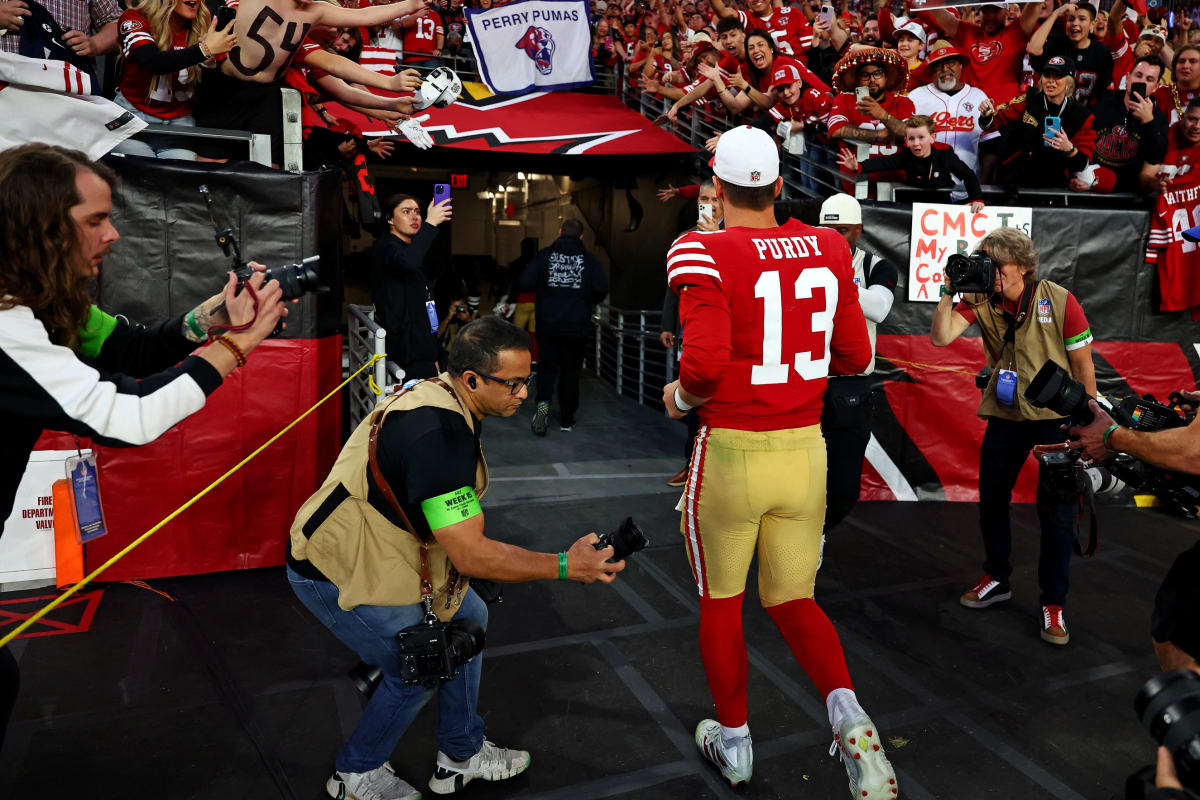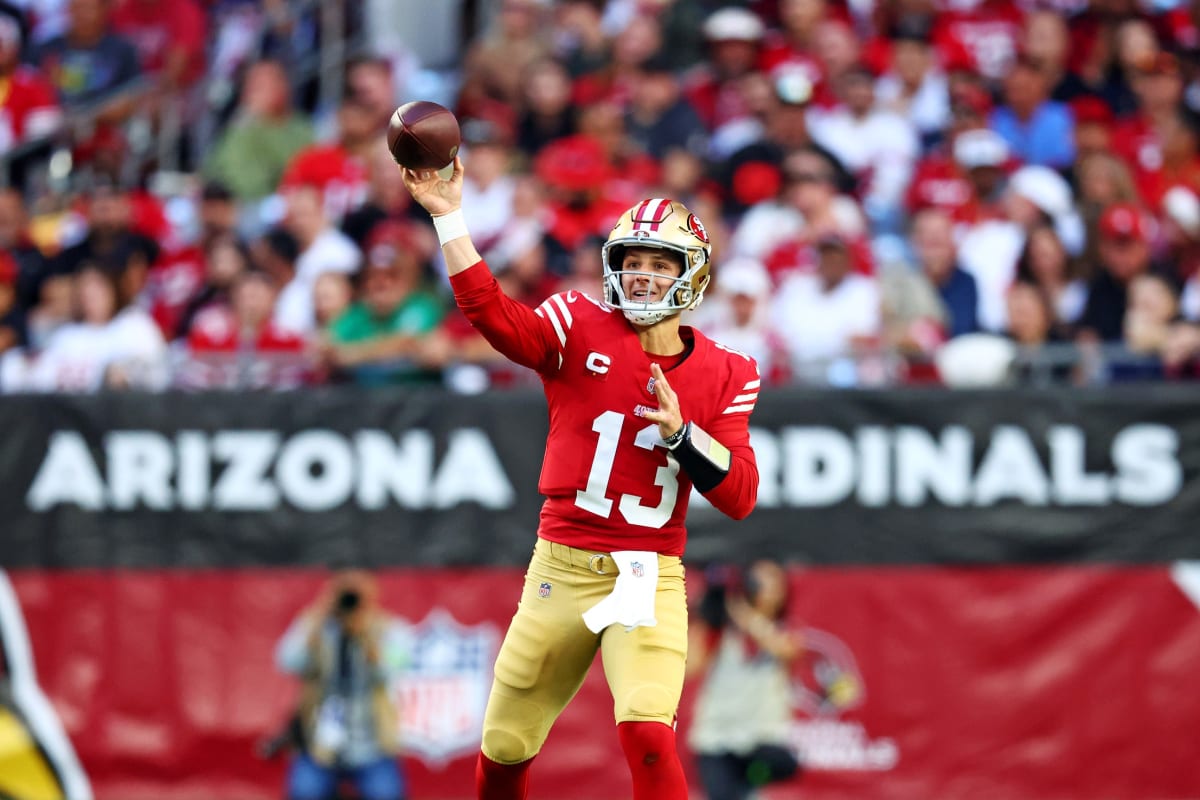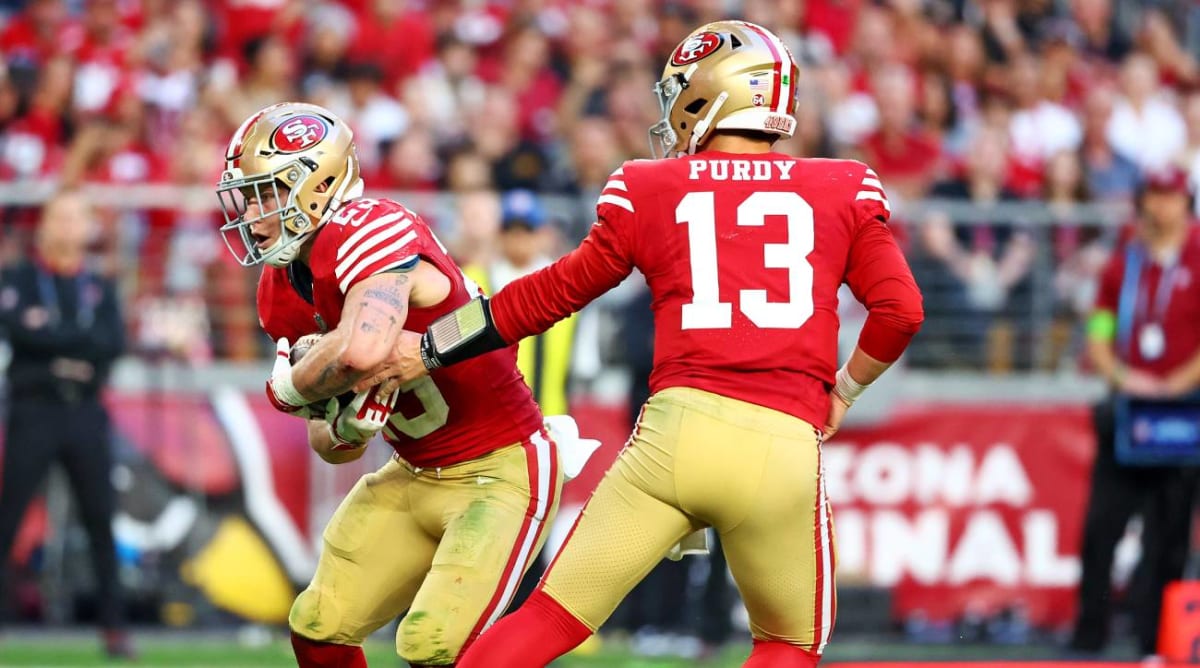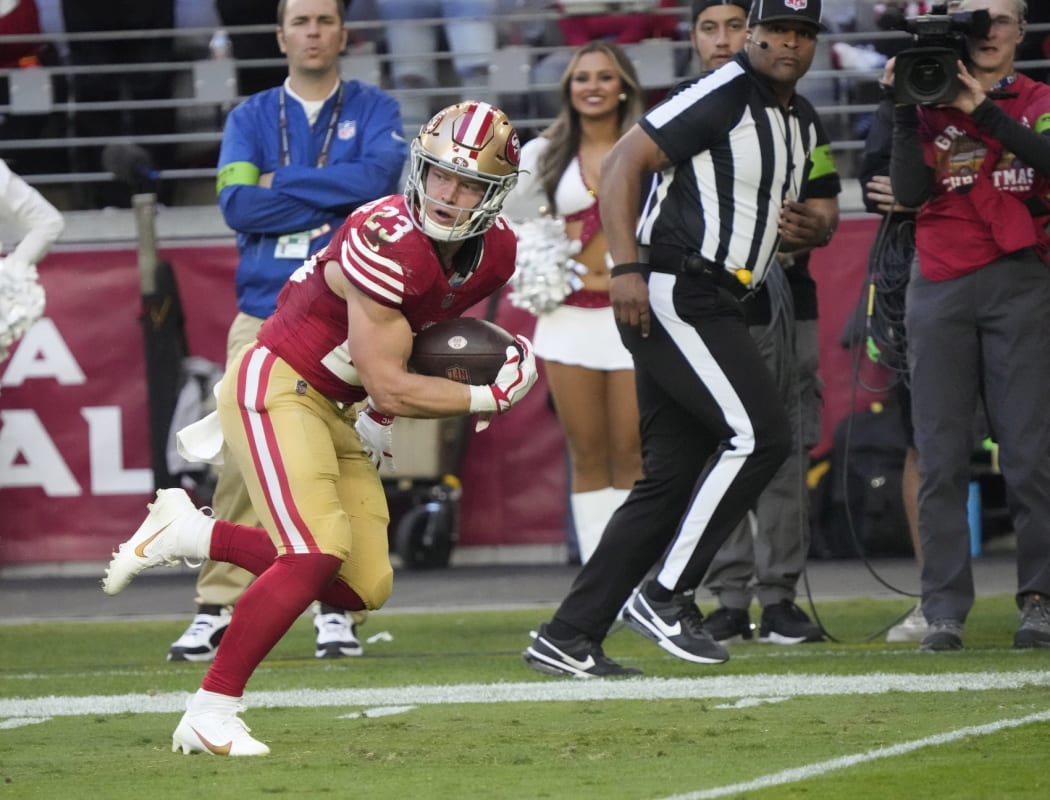As Brock Purdy jogs onto another NFL field, for another NFL start, in a professional football career that’s not as unlikely as it seems but has always been remarkable nonetheless, his private quarterbacks coach logs onto a Zoom call. Will Hewlett knew Purdy before he became a phenomenon, Mr. Irrelevant to Mr. Quite Relevant, the best NFL story that never ceases to get better.
This week provides more proof. San Francisco is on the road, in Arizona Cardinals, where the stadium in Glendale is only about a 45-minute drive from Queen Creek, where Purdy grew up. Before he became Brocktober at Iowa State and made an NFL roster. Before he became a starter, then an injured starter. Each step has been more improbable and more meaningful than the last.
Dozens of friends and relatives have decided to trek to the nearby stadium Sunday. Only now, everything is different for the state’s 2017 player of the year. The Cardinals are honoring an opposing signal-caller during a home game. The majority of their fan base would gladly trade their solid quarterback, Kyler Murray, for Purdy, which would have to set some sort of NFL history—a No. 1 pick swapped for the last selection in an NFL draft. There’s a photo on the big screens of Purdy shaking hands with Michael Bidwill, the Cardinals’ owner. And “The Faithful,” as the 49ers diehards like to call themselves, seem to outnumber the home fans, owing to Arizona’s 3–10 record before kickoff.

Mark J. Rebilas/USA TODAY Sports
The homecoming marks Purdy’s second appearance in what’s now called State Farm Stadium—after the Fiesta Bowl in 2021, when he won offensive MVP amid the pandemic, in front of a mostly empty stadium. He put on a show that afternoon, and all anyone wants on a Sunday two weeks from Christmas is an encore, the best kind of gift, a chance to celebrate their native son.
Pregame/early first quarter: Hewlett is not there. He’s in Florida, where he’s based and with his family, hence the Zoom. As the game kicks off in the league’s afternoon window, he starts with an explainer of Purdy’s offseason, which really started at the end of last season. About that: Purdy was no less than a revelation, a-little-engine-that-starred story about a quarterback who wasn’t a little engine at all. Purdy made NFL history, began his career with seven wins in his first seven starts and led San Francisco to the conference championship. But against the Eagles, he tore the ulnar collateral ligament (UCL) in his right elbow in the first quarter, which pretty much ended the 49ers’ championship ambitions for last season and cast doubt on whether Purdy could replicate his remarkable 2022.
He spent the next two months resting, which was critically important. Purdy’s reps would soon huddle with team officials to plot the remainder of his recovery. But the first item to decide was which of two surgeries he would undergo, and that decision couldn’t be made until a surgeon sliced open his increasingly valuable right arm. And the first cut couldn’t be made until the swelling subsided.
Good news was delivered March 10, when doctors buzzed 49ers officials to tell them Purdy might be ready (or close) at the start of this season. Turns out he didn’t need the dreaded but common surgery named after Tommy John. Instead, he would undergo a newer procedure, one that didn’t exist even 10 years ago. While it’s complicated to explain, what mattered was something called an InternalBrace augmentation, which was central to the newer method and didn’t require a tendon graft as part of the reconstruction the way Tommy John surgeries do.
What mattered even more: The 49ers spent years fashioning a roster as complete and dominant and versatile as any in pro football—and just as many years being considered largely a healthy quarterback away from multiple championships. They advanced to three of the previous four NFC title games, losing two and winning one, only to lose that Super Bowl to Patrick Mahomes and the Chiefs. Their window of contention, already larger than most windows for most teams, wouldn’t remain this wide or this open forever. Except now, after that call from doctors, they knew Purdy was likely to return in six or seven months.
After surgery, rehab and clearance to resume throwing, Purdy went to Jacksonville to visit Hewlett. They focused on throwing specifically, more than they would have had he not torn the UCL in his throwing arm. “Just,” Hewlett says, “making sure the surgery went well.” They built back his arm strength and its stamina, which might sound funny, an arm having stamina, but try throwing 80 footballs or 200 and see how high you can lift yours the next morning. Purdy would throw, then rest. When his arm didn’t hurt the next day, he threw back-to-back days, then rested.
They built from there, with input from the 49ers. The team received videos of each workout, courtesy of Hewlett and his staff, along with data culled from each session and the aggregates. Purdy used gear he got from Driveline Baseball, the cutting-edge training and research facility located south of SeaTac Airport in Washington State. Driveline primarily caters to baseball players, but that made sense for Purdy, because his trainers (including Hewlett) primarily train those who star on diamonds and (mostly) because pitchers (and some of their positional counterparts) undergo the bulk of Tommy John surgeries in sports. While throwing last spring, Purdy wore the same Pulse compression sleeve recovering pitchers use. Far from an ordinary sleeve, this sleeve has an attached workload monitor. It’s a smart sleeve, more or less, and it counts throws and measures their intensity—for each individual throw and for the collective impact on any one arm.
The goal for this portion of Purdy’s rehab, Hewlett explains, centered on restoring confidence and rhythm, the natural parts of quarterback play. “A lot of times, what matters is feeling good about what you’re doing,” he says, “like when the ball comes out of your hands.” Purdy progressed really, really well. So well, in fact, he left for camp without needing to worry about his elbow and whether it had healed. He knew already he wouldn’t need to take precautions to protect his throwing arm.
He targeted being ready for the opener, which seemed improbable in Philadelphia last January.
Ready for the opener he was.

Mark J. Rebilas/USA TODAY Sports
Mid-first quarter to early second quarter, 7–0, Cardinals: The Cardinals scored first, revealing Murray’s answer to the home crowd giving away vibes. Hewlett, meanwhile, remembers to mention the special guest present for offseason training: Chubba Purdy, a college QB with a rocket launcher for an arm, who played for Nebraska last season after transferring from Florida State.
Chubba’s presence marked a different kind of brotherly shove. Brock may have already cemented himself as an NFL force who would soon become an MVP candidate, but he couldn’t touch little bro last spring. There were other pros in attendance—Hewlett trains Anthony Richardson of the Colts, among others—so the stature swap combined with some typical sibling ribbing nearly sent mild–mannered Brock into a few mild tizzies.
One afternoon, Chubba let loose with: “That’s not how it’s supposed to be done.”
Brock, who might be mild-mannered but has always been as competitive and driven as any athlete in pro sports, shot back a look and then, “Well, that’s how we do it.” Meaning in San Francisco, the pros, under an offensive wizard in Kyle Shanahan.
Speaking of the 49ers, they begin their first offensive possession as Hewlett cackles. This week, they’re once again considered the favorite to win the Super Bowl after grabbing that status early into 2023. They lost it during the worst stretch—relative; but to his play, not initial expectations—of Purdy’s young career—then regaining that perch in recent weeks.
Hewlett keeps going. He got a kick out of the brothers’ dynamic, proof that no matter how much changes, some things never do. This signaled an important notion. While much around Purdy had changed, because, of course it did, the soul of what propelled him to stardom remained intact.
On this drive, the obvious becomes even more clear. Purdy steers the 49ers’ offense down field, with Christian McCaffrey serving as a yardage-accumulating, defense-deceiving, touchdown-scoring engine. Their telepathic version of teamwork began with a happy accident, after San Francisco traded for McCaffrey last season but before he moved into the starting lineup. Through that stretch they played together against the 49ers’ mighty first team defense, which, on occasion, they actually shredded.
Now, as Hewlett watches them both dominate another football game, he says, “There’s an element of operation as a quarterback where you throw on time to open guys and you put the ball in the spot where they’re gonna be. There’s an evolution to that, naturally, when you start playing together.” He cites Aaron Rodgers and Davante Adams when they played together in Green Bay, how they operated on a “different wavelength.” For an offense with as many choice routes and option routes and variations of all routes, that’s pivotal for success.
The conversation halts. There’s Purdy, in the red zone, after a nifty play-action fake. He’s moving to his left, which will make throwing the ball awkward. But in creating that awkwardness, most of the 49ers’ offense goes right—and most of the Cardinals’ defense follows. As that happens, Deebo Samuel crosses the field, running from the right to left. He’s wide open. Purdy sees him. Touchdown.
The limited number of Purdy skeptics who still doubt him also grow a little quieter each week. All five of them might look at that pass and think: Come on, so easy; MVP? I could have thrown that. They’re wrong. It’s not easy. Playing quarterback isn’t easy, playing in the NFL isn’t easy and playing for a computer-brained coach, especially this one, isn’t easy. The coach in question freely admits he can be hard on quarterbacks in particular. Part of Purdy’s brilliance lies in running the latest elaborate, intricate, detailed version of Shanahan’s ever-evolving offensive scheme. Another part, the one that separates Purdy from so many others, is running that scheme exactly how Shanahan wants it run.
This play is the perfect example, Hewlett says. Purdy chose the right calls when faced with decisions at the line of scrimmage on the opening drive. He sold the handoff so well Samuel could have caught the pass, stopped, ate lunch and still scored. Purdy even threw the ball with his body turned the wrong way, which is far more difficult than it might seem. He can hardly add torque to the attempt because he cannot go through a full throwing rotation.
“The play-action element, the misdirection, the motion—how they operate was really evident,” Hewlett says. “You can say that was an easy throw. But there are nuances to the fake and how clean that came off. Those are things he works on every day. That’s awesome.”

Mark J. Rebilas/USA TODAY Sports
Early second quarter through early third quarter, 7–7: The 49ers’ offense doesn’t touch the ball again until the second quarter; instead, Purdy loses a possession in the best possible way—from an interception cornerback Charvarius Ward returns for a score. During the lull, Hewlett explains his in-season evaluation process. He grows close to players such as Purdy, which can threaten to skew his objectivity. That, combined with the four children he has at home, is why he watches each game featuring a player he coaches once—in full and informally—before he really digs into the tape.
His two youngest, both major 49ers fans, often partake in those viewings with him. Sometimes, they even ask him to text Purdy about one question or another later that evening. When San Francisco played at Jacksonville earlier this season, the Hewletts sat with the Purdys in the nosebleeds, everyone cheering and catching up.
This took place in Week 10, after the “bad” stretch that Hewlett says wasn’t really all that bad. Purdy played well through the season’s first five weeks, collecting five wins and dismissing any lingering concerns about his elbow. But in the next game, at Cleveland, he turned in his worst performance as a professional quarterback. More than half his attempts fell incomplete, while another was intercepted. The Browns’ defense limited him to 125 passing yards. The next week, at Minnesota, he threw two more picks in another loss. The next week, at home against Cincinnati, he was intercepted twice more.
The skeptics came out in full force right around then. See! They told you! This was all a mirage, a magical stretch born from elite teammates, a strong defense, genius play-calling, deceptive schematics and a little luck. Hewlett saw such vitriol as little more than lazy evaluations. When the 49ers won, Purdy became the second coming of Steve Young; when they lost, he morphed into Steve DeBerg (for the younger crowd, he’s the quarterback Joe Montana replaced).
No one in Purdy’s inner circle expected him to crumble, let alone respond to any of the nonsense circulating with increasing volume and intensity each week. But Hewlett couldn’t help himself. He kept searching Twitter and other forms of social media to gauge reaction. Most of it was typical, flat wrong, owing to difference in evaluation and experience. Any fan not watching the all-22 tape can hardly see how a play begins to unfold. Even then, they wouldn’t know the intention of each player on that play; at best, they can only guess; even then, they couldn’t even guess at what might have gone wrong mechanically, how injury might have impacted the throwing motion and a host of other factors. It’s easy to blame the quarterback. It’s also often inaccurate to blame the quarterback alone.
Against the Vikings, for instance, Hewlett acknowledges that Purdy didn’t have his best day. He also had a “pretty darn bad concussion” but cleared protocol and stayed in. When Hewlett checked in afterward, he says Purdy responded that he felt like an 8-year-old, like he was “literally losing my mind.” Or how, even in the Browns’ disaster, he still gave the 49ers a chance late to win. (San Francisco lost on a missed field goal attempt.)
“It’s interesting, right?” Hewlett says. “Quarterback and kicker are the only positions where it seems like the expectation is perfection on every play.”
The corresponding problem with that expectation is a lack of appreciation of the finer details of elite quarterback play. If every week is disaster or euphoria, there’s no room for those. Sometimes, Hewlett wonders whether the skeptics are still skeptics only because they want to wait long enough to have evidence they were right. “If his luck were going to run out, wouldn’t it have already?” he asks, fairly.
If the stretch—and the criticism—bothered Purdy, he didn’t show it that day in Jacksonville. When he met with everyone afterward, he spent time with Hewlett’s oldest, a high school quarterback who wanted tips.
On Sunday, Purdy flips passes forward while in traffic, lofts others over defenders heads and slings others through traffic like darts headed for bull’s-eyes. He finds McCaffrey for a touchdown with some nifty footwork in the pocket that allows him to rotate through progressions and still be in the proper position to throw. He also briefly leaves the game after taking another hard hit that snaps his head back into the turf. He stays down after that one, long enough to make “The Faithful” question their, well, faith. He heads to the injury tent. But he comes back, and Hewlett is relieved.
On the 49ers’ first possession of the second half, Purdy drops back on third-and-long. Rushers close in immediately. Somehow, he sees tight end George Kittle streaking up a seam on the right side of the field, exactly as Kittle is supposed to on a hot route. Purdy throws off his back foot, off balance, can’t turn, while getting clobbered. The attempt is timed perfectly. Kittle snags the pass in stride and picks up 35.
“What a throw,” Hewlett says.
Early third quarter through fourth quarter, 21–13: How about the next one? No shotgun. Drops back. More pressure. Turns around and not just a slight turn but a full pirouette. Scrambles to his left, absent dizziness. And there he is! McCaffrey! Not just open down the field. Entirely uncovered. So open, in fact, he catches the pass, falls down, gets up and scores before a defender can even touch him.
Later the same quarter, Purdy throws his fourth touchdown pass. This one goes to Samuel, and it’s a pretty, low-arcing lob to his back shoulder—the only place that would have worked there.
This pushes the discussion to the obvious place, the 49ers’ offense and how, when close to full health and in rhythm, it’s pretty much unstoppable. It’s difficult to defend the 49ers when accounting for one or two of their three skill-position superstars. But when McCaffrey, Kittle and Samuel are healthy, 15 defenders probably couldn’t stop them. Especially with Brandon Aiyuk (more than 1,000 yards receiving) and various role players, including the best fullback in pro football, Kyle Juszczyk. Hewlett argues, also fairly, that Purdy elevates the combination, which became clear when he left the NFC championship game and the Eagles rolled to a blowout victory. He’s not simply along for the ride.
See, Hewlett understands what people get wrong about Purdy. For years now, quarterback development has started earlier and evolved far beyond previous best practices. If Mr. Irrelevant is a quarterback, he’s not some throwaway draft pick; he’s likely to stick, at least, in the NFL, as a backup or otherwise. Football evolved to Purdy, as his game evolved to excel within its latest evolution. Gone are the tall, stiff, drop-back-types of yesteryear. Mobile, tall-enough quarterbacks—like Purdy!—have replaced them. What matters is coaching, accuracy, deception and offensive talent. Purdy has all of those in spades.
“He was always gonna be a dude,” Hewlett says.
As Richardson prepared for the NFL draft last spring, he told Hewlett he thought NFL offenses might be easier in some respects because of the structure baked into all of them.

Michael Chow/The Republic / USA TODAY NETWORK
The final score: 45–29: San Francisco is 11–3 with three games left in the regular season, as Philadelphia scuffles and mighty Dallas gets spanked at Buffalo. Purdy is no longer Cinderella sans slipper. He’s Montana once more, king of all kings. And, while that’s undoubtedly early and overstated, he’s also forced afterward to analyze two MVP candidates from the same team—and one of them is him.
Hewlett says the MVP debate has never come up with Purdy. Although, by numbers alone, he’s certainly earned his prominent place in that conversation. Recently, Hewlett joked with Purdy’s agent about his future in State Farm commercials. “Those spots are already taken,” the agent joked in response. Hewlett even did the math recently, when Shohei Ohtani signed with the Los Angeles Dodgers, and his massive, massive contract meant Ohtani would earn Purdy’s current salary in a handful of games.
Purdy finishes Sunday’s victory on the bench, resting, no need for unnecessary risk. His line: 25 attempts, 16 completions, four more touchdown passes, 135.3 rating. San Francisco clinches the NFC West for the second consecutive year, which marks its first back-to-back divisional triumph in more than a decade (2011 and ’12). But when asked who should win MVP, he pointed not toward his chest but toward McCaffrey.
He sorta has a point. Against the Cardinals, McCaffrey amassed 187 yards from scrimmage, caught five passes, carried 18 times and scored three touchdowns. There are a handful of NFL teams with truly elite quarterbacks this season—Cowboys, Eagles, Ravens, even sometimes the Bills. But there’s no player in pro football quite like McCaffrey, who, in two games against Arizona this season alone, scored seven times. After scoring via rush and via catch on Sunday for the 15th time in the same game, he tied Marshall Faulk for the most such games in league history. But Purdy has posted six games with ratings at or above 130, tied for the most in a single season in NFL history with Aaron Rodgers, Tony Romo and Russell Wilson.
Maybe they can split it? After all, one isn’t as powerful, frightening or dominant without the other. Hewlett doesn’t care. Purdy is healthy, in top form and ready for what’s next. Maybe the skeptics will stick around anyway. Just don’t mistake wanting and waiting to be right for accuracy. Purdy has proved almost everything he can in the NFL—at this point, the comparisons to Tom Brady don’t seem quite as outlandish. We’ll have to see about the rings.







